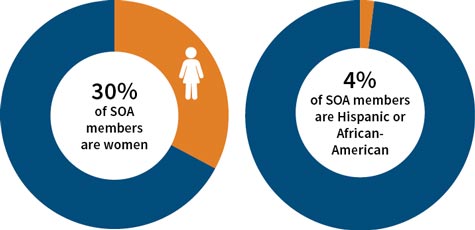A Multipronged Approach to Removing Barriers
The SOA stands up for diversity and inclusion April/May 2018Over the past two decades, the Society of Actuaries (SOA) and the Casualty Actuarial Society (CAS) have worked together to increase the number of women and racial and ethnic minorities working in the actuarial field. Women make up approximately 30 percent of the SOA membership. The 2017 class of new fellows is approximately 33 percent female. Though work remains to be done, progress is being made on the gender front. Unfortunately, the same cannot be said for progress on racial and ethnic diversity.

In 2018, Hispanics and African-Americans continue to be woefully underrepresented in the actuarial profession. Recent estimates from the U.S. Census Bureau put the representation of each group at just 2 percent.
An in-depth report released in fall 2017 titled “Diversity and Inclusion Research Initiative” uncovered many of the reasons racial and ethnic diversity remains so low. Conducted by C+R Research on behalf of the SOA, the CAS, the Actuarial Foundation and the International Association of Black Actuaries (IABA), the study revealed barriers at each point along the career pipeline that disproportionately impede minorities’ entry into the profession.
These obstacles include low awareness of the field and a lack of mentors and role models who can demonstrate that “actuary” is a viable career option for minority students, and insufficient financial support for both education and examinations (see the “Five Barriers” sidebar).
The SOA takes these findings seriously and is working hard to ameliorate these obstacles. Taking a multipronged approach, we believe we have the power to change the culture and increase opportunities for minority students and candidates across the country.
Starting at Home: Internal Actions
In June 2016, the SOA published a diversity statement on its website to clarify its goals for diversity and inclusion. It reads, in part:
The Society of Actuaries (SOA) best fulfills its mission when it is diverse and inclusive of all individuals. Openness to and acceptance of diverse perspectives, cultures and backgrounds helps to attract the best talent and ensures the overall inclusivity of the actuarial profession.
This statement, together with the efforts of our Inclusion and Diversity Committee, demonstrates our commitment to increasing awareness, diversity and community.
That commitment is further evident through the information we publish and the influential speakers we host. Articles on diversity, mentorship and career development appear regularly in the Management and Professional Development Section newsletter and across our publications. The Actuarial Teaching Conference and the Actuarial Research Conference consistently include diversity-related sessions, and the Annual Women’s Leadership Forum has been a mainstay at health meetings since 2015.
Through Candidate Connect, we take our goals for increased awareness and diversity directly to the students. This important newsletter helps to break down barriers by providing information and resources to students and candidates regarding exam preparation, networking opportunities, employment and changes in the field.
Finally, to help us track our progress in increasing diversity, we gather essential demographic data about our membership. When minority candidates see they are not alone, they will feel more welcome in our profession. If you have not yet volunteered your demographic data in your SOA profile, please do so now, confidentially.
Partnership, Sponsorship and Support
For the four organizations involved, publication of the “Diversity and Inclusion Research Initiative” was a proud achievement. This report was three years in the making and represented a true collaboration, with all parties contributing essential resources. The research has shed light on a problem we have known about anecdotally for years. At last, we have the data to help us move forward.
And we are off to a good start. In 2017, the SOA supported the grassroots creation of the Organization of Latino Actuaries (OLA). We intend to provide the same support to OLA in the coming years that we have provided to IABA and other organizations focused on diversity. Our missions are deeply connected and our continued coordination will have a positive effect for our members and the profession.
Another joint effort, the LGBT and Allies resource group powered by the SOA and the CAS, will launch in 2018. This group will further engage a diverse population and welcome them to the actuarial profession.
However, the centerpiece of the SOA partnerships for diversity is the Joint CAS/SOA Committee on Career Encouragement and Actuarial Diversity (JCCEAD). This committee strives to increase awareness of the actuarial field among high school, college and university students, educators and others. These efforts reach students as well as influencers who can act as mentors and guide students who wish to become actuaries.
The JCCEAD sponsors several programs specifically designed to remove barriers:
- Conferences. The National Council of Teachers of Mathematics, Joint Math Meeting, American Indians in Science and Engineering, Out in STEM, Advancing Chicanos/Hispanics and Native Americans in Science each provides support and education for a diverse group of potential actuarial candidates.
- IABA Actuarial Boot Camp. This four-day workshop provides real-world actuarial experience along with interviewing and other soft skills needed to land an internship, with a focus on black actuaries.
The Five Barriers
Each stage of the career pipeline presents a new potential barrier for entry into the actuarial field. While all students face these hurdles to some extent, the effects are greater and more persistent for minority populations.
- Awareness of the field. Just 12 percent of surveyed African-American and Hispanic college freshmen had heard of the actuarial profession. In contrast, 25 percent of college freshmen from other backgrounds had heard of this profession. Lack
of awareness has been shown to
be the barrier with the farthest-
reaching effects. - Consideration of actuary as a viable profession. Because of the low representation of minorities within the field, many African-Americans and Hispanics do not see “actuary” as a profession that’s right for them. The time and money required to take and pass exams also make some candidates feel being an actuary is not a viable option.
- Preference over other STEM professions. The image of an actuary may not be as attractive as medicine, computer science or another STEM field. “Drawing minority students into the profession requires positioning the career as meaningful, attainable, rewarding, prestigious and secure,” the researchers report.
- Intent to take and pass the exams. The actuarial credentialing process requires time to prepare and take the exams, and money to pay for taking (and retaking) exams. In the survey, more than 50 percent of lapsed minority candidates indicated financial support for exam fees was insufficient to meet their needs, compared to 22 percent of other lapsed candidates. Furthermore, 31 percent cited the cost of exams as a reason they stopped pursuing a career as an actuary, compared to just 7 percent of other lapsed candidates.
- Employment and retention. Three factors—screening and stereotyping of resumes based on names and schools, subconscious racism and a lack of diversity in the workplace—combine to create an office environment that is unwelcoming to minority candidates.
The JCCEAD-maintained website, BeAnActuary.org, serves as a resource for candidates who want to learn more about the profession. Some of the resources found on the website include:
- Information on exam fee reimbursement for minority candidates
- Links to organizations serving Hispanics, African-Americans, Native Americans and other groups
- Information on scholarships for minority students and candidates sponsored by actuarial organizations and companies
- Links to summer internship programs for high school students
The website also has a companion Spanish-language microsite. While English or French proficiency would be necessary to pass SOA examinations, research shows that families have a huge influence on attracting candidates to the profession, so the Spanish website may be a key tool in reaching Latino students.
Math Motivators is yet another influential program that the SOA sponsors. Created by The Actuarial Foundation, Math Motivators is designed to “help close the achievement gap by establishing a volunteer-driven math tutoring program that pairs low-income high school students with professional actuaries and college students majoring in actuarial science, mathematics or math education.”
The decision to support these efforts was an easy one to make. With these types of initiatives fully funded and supported, we can mitigate the obstacles that impede the progress of African-American, Hispanic and other minority students in achieving their goal of becoming actuaries. We can change the culture and create a more diverse and inclusive workplace.
If you attended the SOA Annual Meeting & Exhibit in 2017, you may have seen a keynote presentation by Scott Page. In his presentation and in his book, The Diversity Bonus, Page shows how diverse teams are more effective at solving problems that require creative solutions. Bringing diversity to the actuarial profession can thus make us all more effective. Everyone wins.

